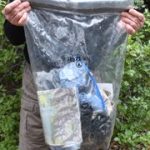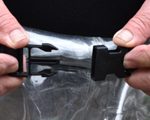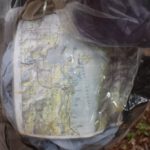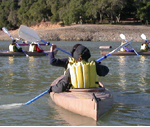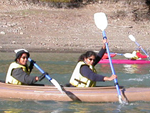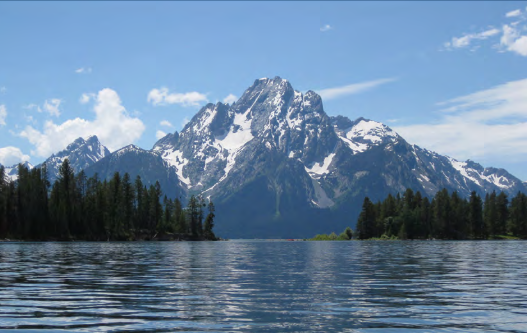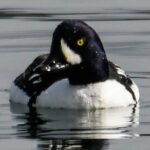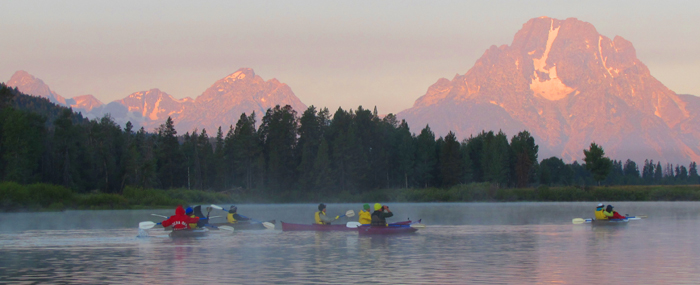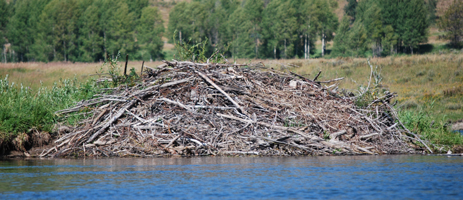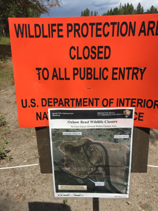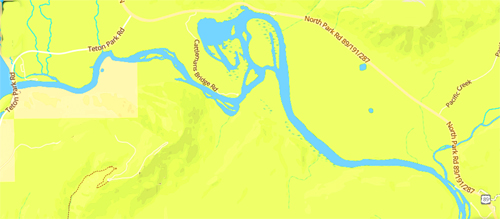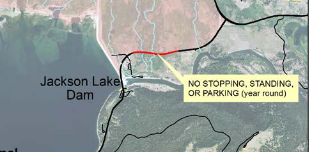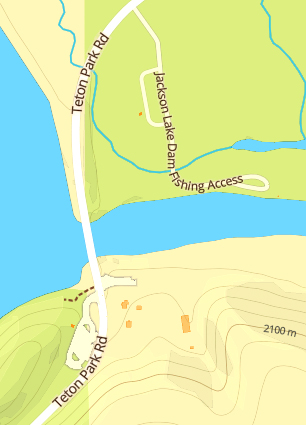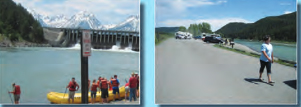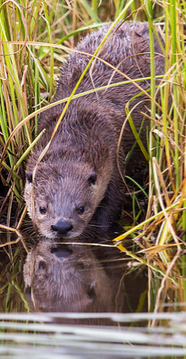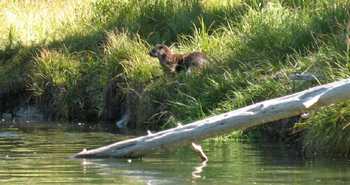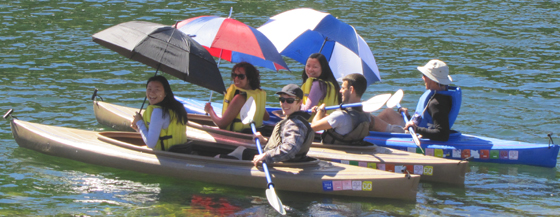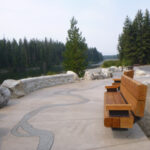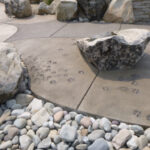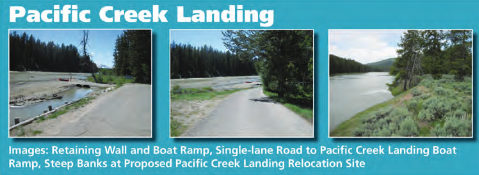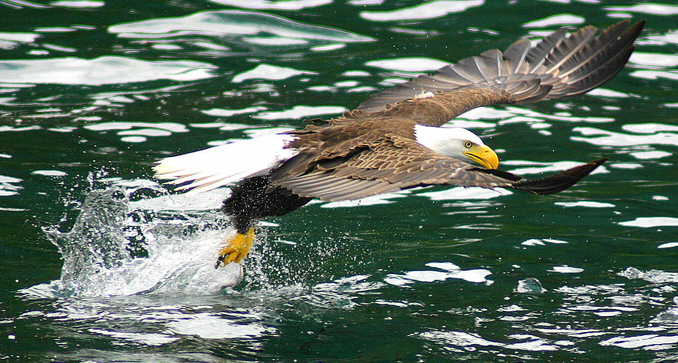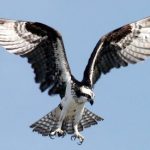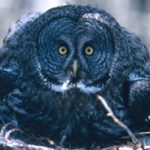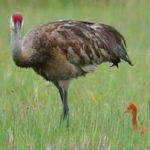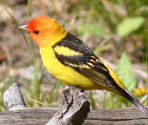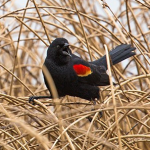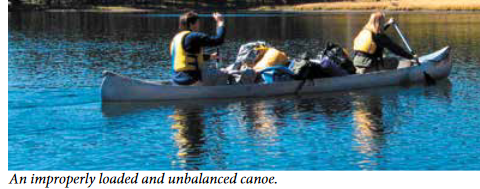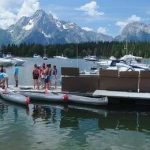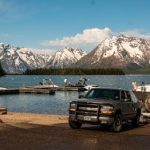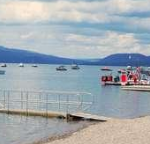This page includes information about the De Anza College Outdoor Club trips to Grand Teton National park for kayaking, links to water level information for Jackson Lake and the Snake River, to park rules about boating and float trips, how to load a kayak on a car, how to do a canoe over canoe rescue, and more. The main trip information page is at Grand Tetons
Because we have our own boats/gear, we can be out at sunrise, when other people who need to rent boats (canoes, kayaks) can’t be out as easily:
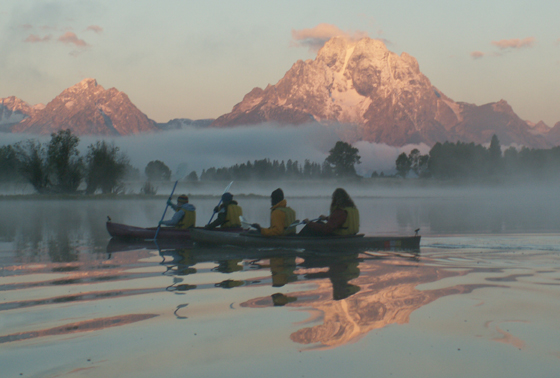
Bring your full rain suit (waterproof hooded rain jacket and pants), warm clothes for under it as we do not turn back when rain starts unless there is a thunderstorm, and your rain suit can help keep you warm if there is wind. (If you do not have the rain gear with you when we are going kayaking, even in (temporarily) sunny weather, you will not kayak that day.) Advice on gear.
You should also plan for other camera, etc. waterproofing, when out sightseeing and hiking. (Weather could cancel/ postpone kayaking as we never risk kayaking during thunderstorms.)
You can borrow a dry bag from the club advisor (she might have enough for one for every two people, or maybe one per person).
How to use a dry bag when out kayaking
Part of our club policy for kayaking includes: You do not need experience to go on our flat water paddles, but you do need to read and follow all directions, including this whole page for our Tetons trip. You must wear a securely fastened lifejacket. Out paddling you must agree to stay with the group. Each kayak (or canoe) must be in talking distance, not just line of sight, of another kayak. This means fast paddlers may have to wait for others, and the next-to-slowest people will have to wait for the slowest. Fast paddlers can go out to the lead, then double back and visit with people at the back if it gets too boring for them on longer routes. Stronger paddlers can volunteer to paddle with a slower partner.
If you bring a stand-up paddleboard (SUP) you own, you will not try to use it while the club is paddling / touring around since we paddle on moving water part of the time.
Fall and/or summer kayaking / canoeing
Kayaking will probably start with a
brief outing on Colter Bay, just down the road from the campsites/cabins. This is flat water with little current and is a good way for people with no kayaking experience (such as our usually May and October Baylands reserve trip) to get a first experience and for everybody to get familiar with the kayaks we use.
This is a first time kayaking experience for some people, so we start with a lesson and some paddling by two people in a kayak, the same way it will be for most kayaking touring we do on the trip. We can plan to have someone more experienced team up with someone who is learning, and have always found a way for everyone to learn enough to do long sightseeing kayaking in pairs.
These are not the kind of kayaks that you need to know how to do an Eskimo Roll if they tip over, but they are also not the sit-on-top kind okay for ocean use.
They are like small canoes, for relatively flat water lake or reservoir use, not rivers or oceans. The seats can be adjusted forward and back to accommodate one person or two people for touring around. The paddles, one shaft with blades at either end, can be adjusted for true kayak paddling with blades offset at right angles to each other
(see the paddles in the photo below of paddlers on Colter Bay). 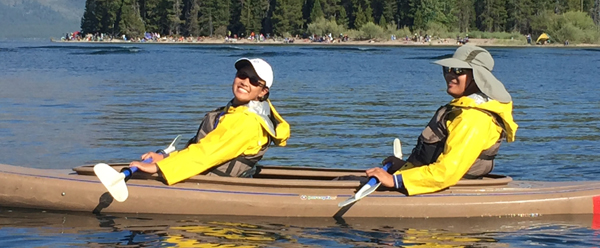
Kayak seats can be adjusted forward and backward to accommodate people’s leg lengths:
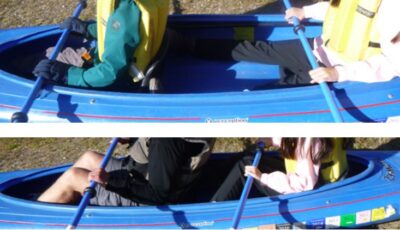
We start with a practice using the paddles before we even go out on the water:
People can help unload the kayaks or do other chores

One person might be strong enough to lift a kayak off the trailer by themself, but for safety, we require at least two or even three or four people under each kayak as it is unloaded or loaded:
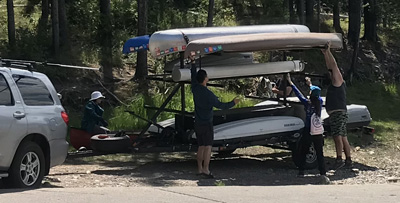
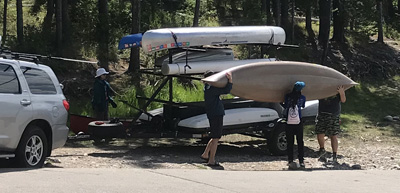
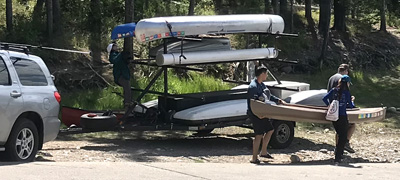
There are small, medium and large lifejackets. Each person will need to try some on and choose one before the trip, so we can pack a good size / style for each trip participant. De Anza College Risk Management requires the use of the lifejackets, even for strong swimmers.
For most of our kayak touring we go 2 people per boat. Once people get used to paddling, they quickly figure out that if they can paddle simultaneously (both people paddle on the right hand side, then both paddle on the left hand side), they will go faster (and then their paddle blades won’t bump against each other). It can work quite well to have the person in the front (bow) of the boat paddle, and the person in the rear (stern) tries to match them, dipping their paddle in the water and pulling through the water at the same time.
Here, at the beginning of a lesson, the inexperienced kayaker in the rear is not matching the experienced paddler in the front end of the kayak:

In the photo on the left below, the two kayakers have not yet figured out how to consistently paddle simultaneously, in the photo on the right, the two paddlers are better at paddling simultaneously:
The first lesson sometimes also includes “parking’ the kayak at the shore, then using a paddle to push it off of the sandbar:

– – – – – – – – – – – – – – – – – – – – – – – – – – – – – – – – – – – – – – – – – –
The Colter Bay Marina is at the end of the road below the Colter Bay cabins and Colter Bay campground where we often stay for this trip.
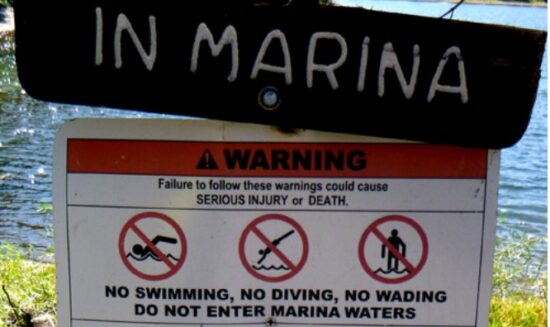
The marina has a ramp where we launch from and then paddle out to one of the large coves on Colter Bay.
Ramp is at the end of the row of boat docks in this photo:

Ramp is at the end of the row of boat docks on the upper right of this aerial photo, bays we paddle out to and in are also on this photo:
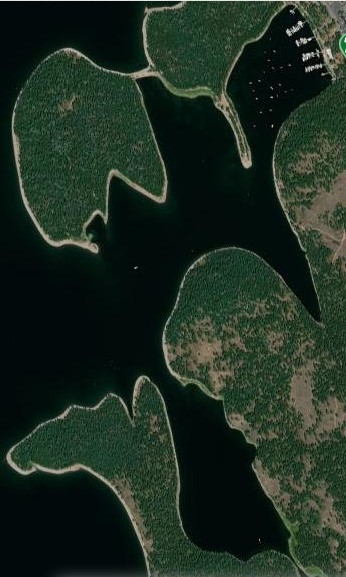
Here, the Colter Bay launch ramp when the water is a bit low, but we can still launch.
There is space for multiple kayakers and canoeists to launch and still leave space for a boat on a trailer to back down into the water, so we always aim to pull the kayak trailer over to the side or even down to the gravel area to the side of the paved ramp.

or here is what it looks like when it is too low for even kayaks to launch:
![]()
Don’t be surprised on our fall trips if you go to take a look and find that the marina is all mud. In September of 2002, 2004, 2005, 2021 and 2022 the lake was being drained so much for irrigation, etc. that the marina area was a mud flat. (But that meant Oxbow Bend had deeper water and we could kayak all over in it). In 2010 the oxbow had shallow water and we could not explore as much.
You might be lucky enough to watch a bald eagle soaring over you as you launch
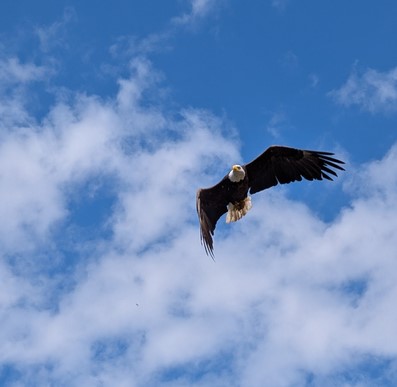
then catching a fish
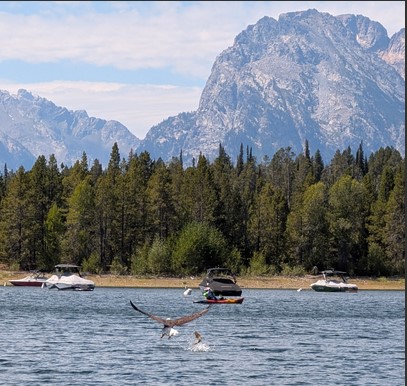
Here, a bit past the marina, the view out through the entrance to Jackson Lake from Colter Bay towards Mount Moran as seen from out on the water:
Most years we have also launched at String Lake, it’s a good place to have a beginners paddling lesson as the water has relatively little current. There’s a lot of parking (IF you get there early enough), a canoe launch area, picnic tables and restrooms.
String Lake has a parking lot for people with canoes / kayaks to use the non-motorized, hand-carried boat launch ramp, and people are discouraged from parking in that lot if they will not be launching a boat.
We have trailers to tie under the kayaks and canoes on to move them to the launch point much more easily than hand carrying them:

Sometimes boaters have needed to ask people picnicking or just sitting at the lakeshore at the end of the canoe launch ramp to move so they can get their canoe through to the water:
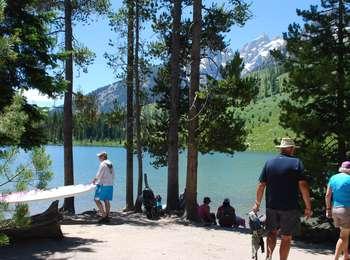
So the park service put up signs asking people to picnic elsewhere:
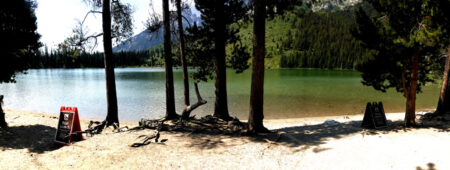

Parts of String ‘Lake’ are so shallow that you can easily get stuck. You might see lines in the sand on the bottom. or paint on large rocks that the keels of canoes and kayaks have left. And we frequently find prints from elk, deer or moose.
Here a trip member balances on his kayak after it got stuck.
If it were not firmly stuck in the mud, it would be dangerous to stand up in or on.
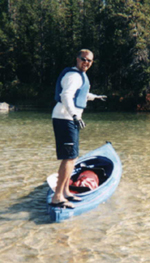

One year we finished kayaking just as it started to rain, lightly at first and then just after we finished loading and tying down the kayaks, heavily.
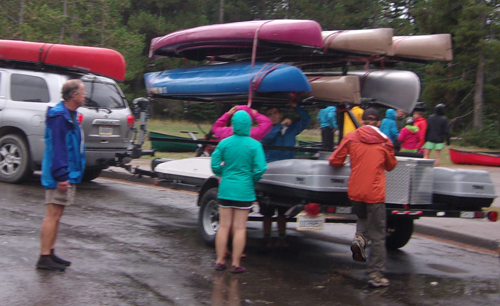
If no rain, after paddling in shallow, relatively warm (less cold?) String Lake we might swim:

After our paddle, people have planned a picnic, (we can show you a semi-private beach section to sit and have lunch at)
and sometimes someone brings a stand-up paddle board, which they may find can be pumped up more easily in the parking lot than at the small launch beach:
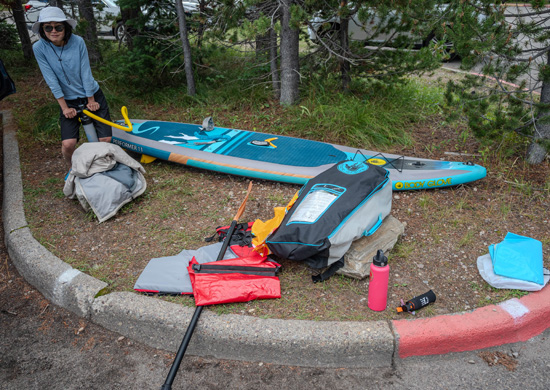
An Audubon website said that at the Oxbow “you might see Trumpeter Swan, Barrow’s Goldeneye, Common Merganser, Common Loon, Western Grebe, American White Pelican, Osprey, and Sandhill Crane.”
At String lake (described above) and the Oxbow (described below) we often see Merganser ducks with chicks swimming behind mom in a row:

and sometimes many Barrows Goldeneye ducks:

photos below of Oxbow Bend are by Quang-Tuan Luong/terragalleria.com, all rights reserved.
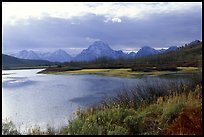
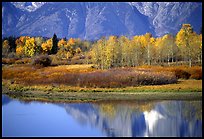
Almost every year we have made
at least one
pre-sunrise launch at Oxbow Bend on the Snake River. It winds back and forth in various channels, only some of which are deep enough for kayaks in drought years.
According to a park brochure, Oxbow Bend is “a cut-off meander” of the Snake River which “provides a rich habitat for a diverse array of wildlife including herons, waterfowl, pelicans, muskrats, beavers, river otters, and moose.” We have seen all these animals and more over the years. You might or might not see them on this trip. 360 degree view from along the highway.
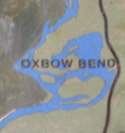
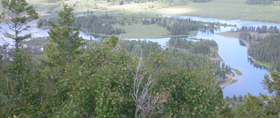
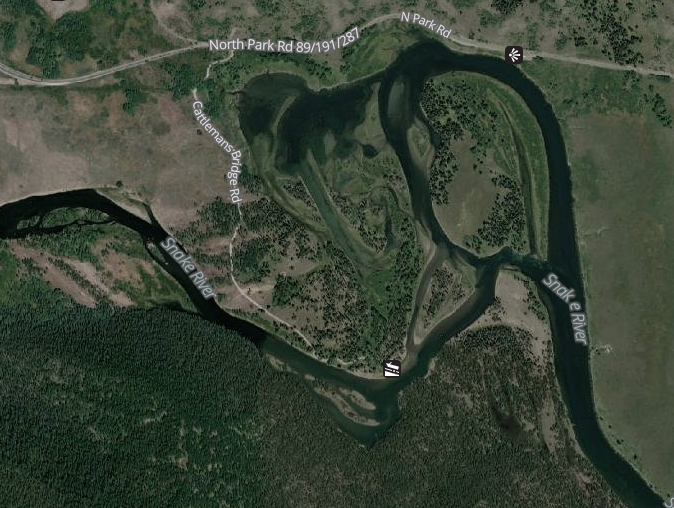
The beavers are likely to be in their homes during the day, such as this one on the shore out into the Oxbow where only paddlers or hikers can see it:
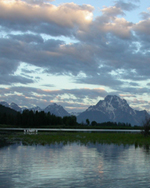
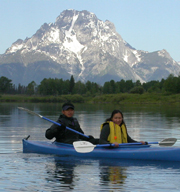
http://www.ejphoto.com/oxbow_bend_pano.htm
More than one year we have seen elk on an island within the Oxbow. Below, from 2024, we were paddling slowly and quietly, and came upon a elk cow and two calves, who got up and walked to an inner part of the island they were on:

while we sat quietly and watched them
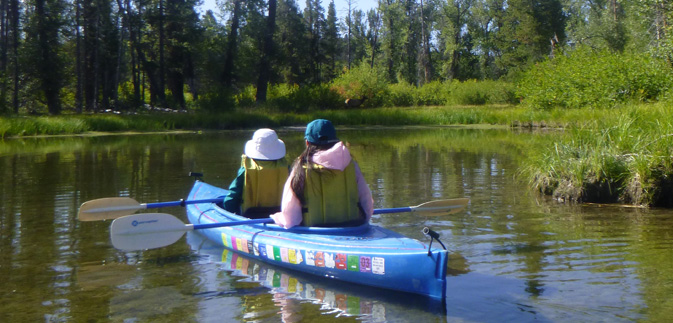
We have not yet experienced a fall Oxbow Bend sunrise or sunset that was lacking:
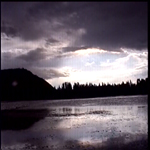

![]()
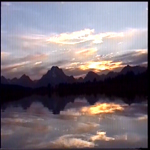
The Oxbow is sometimes closed to foot travel, but open for kayaking.
Going kayaking at sunrise requires getting up while it is still dark to hook up the kayak trailer for towing:
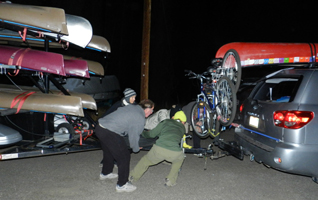
Everyone is expected to keep up with the group, so if you envision yourself just going out a few hundred yards and sitting around when we are exploring, don’t sign up for this trip. Sometimes you have to paddle hard to keep the wind from pushing you where you don’t want to go, or to stay with the group. If we have a hike or picnic at a destination and you don’t want to participate, you must wait. Water depth on the Snake river averages 2-3 feet but exceeds 10 feet in some parts. We need to take into consideration traditionally strong upstream winds. Weather in the Tetons in the fall can occasionally be quite cold, so no water fights are allowed.
Snake River Water Temp: 57.38°f August 16, 2025,
60.08°f August 31, 2025
(water in a pool you swim in might be 85°f).
When we are out on Oxbow Bend we are there to watch ducks, birds and possibly mammals. Some of the time we may not paddle much at all, and just sit quietly and watch. We will see more animals if we are very quiet at Oxbow Bend. Out on String Lake, or one of the inlets/islands near Colter Bay, where we might have a practice paddle for first timers before we try Oxbow bend, we can have more talking.
We sat in our kayaks and watched this Bald Eagle eating a fish for at least fifteen minutes one morning. No other people could have watched this from shore as we were in behind a couple of islands. Magpies were darting in and sometimes getting a few bits, and seemed to be trying to make the eagle fly away and leave them the fish.
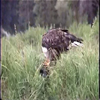
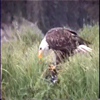
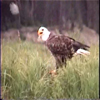

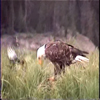
Was it the same eagle we saw the next year, while otters stole his fish? There are more pictures of these two mornings at: Grand Tetons Bald Eagles
Another morning we got out well before sunrise and launched into thick mist. We went around one corner and saw a moose cow and calf on an island so we just sat still and watched. In the opposite direction, on another island, were another cow and calf. Photos were impossible, as the cameras couldn’t decide what to focus on with all the fog. We watched for at least a half an hour, and we got a little cold, despite the layers of warm clothes. We decided to bring insulating pads for canoe/kayak seats in the future. A while into sunrise the second cow entered the water and started swimming. Her calf was still on the bank. We heard her call quietly. Then the calf started swimming too. They crossed to the safety of another, bigger island. At one point we could tell that she was in water depth where she could walk, but the calf was still swimming. The picture below is from a video I was barely able to take in the low light and mist.
If we had started paddling after sunrise we would not have seen them.

Yet another morning on Oxbow Bend we watched a bull moose thrash bushes with his antlers then a second later start grazing.
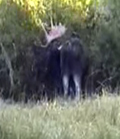


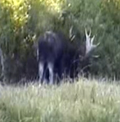
After more eating he moved elsewhere.
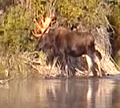
On another island we found a cow napping, and a bit away from her, another cow browsing.
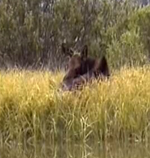
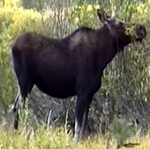
And on another morning, a cow moose who wanted to eat, but her calf wanted to play
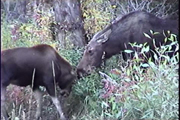
more pictures of these two are at: cow moose and calf
Photo below of the Oxbow, with Mount Moran in the distance by Fred Hanselmann http://www.hanselmannphotography.com/Pictures_of_the_tetons.html)

A five mile stretch of the Snake River from Jackson Lake Dam / Cattleman’s Bridge just above Oxbow Bend, (with paddling around in Oxbow Bend as described above) down to the raft launch just past Pacific Creek at the landing north of the Moran entrance station, works if we shuttle cars. This is an all day adventure, so we pack as-extravagant-as-possible-picnic-food
for during the paddle and for after we re-load the kayaks onto the trailer at the end.
(Most canoe / kayak rental companies do not let people use their rentals on the river at all.)
Here is the route, left to right along the stretch of river in this map:
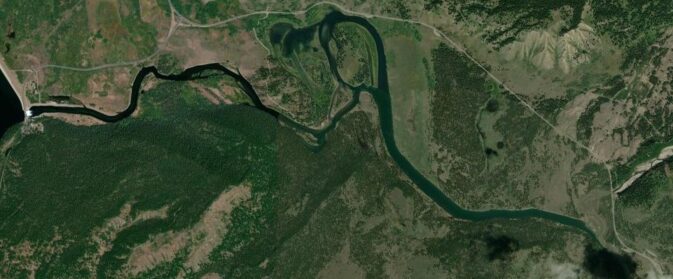
On the way to our launch point, coming from the north (Colter Bay, for example), a signed section of the “Teton Park Road (TPR) between Jackson Lake Dam and Jackson Lake Junction with dense vegetation along the road is closed to all stopping, standing, and parking. This is a year-round closure.”
See the red stripe on the map below:
We start at a formal launch point down a side road from Teton Park Road (TPR), (the white circle of roadway to the right of to the word “Access” on the map below)
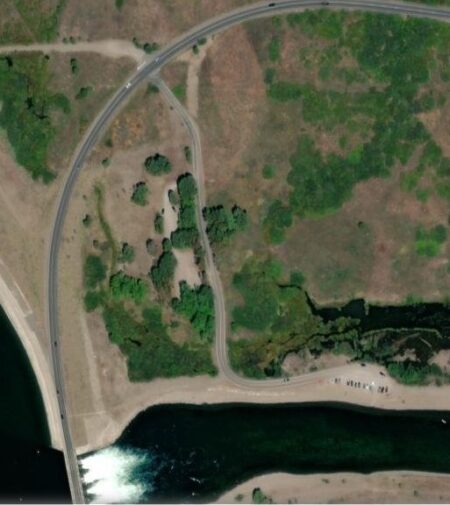
We launch on a slope/ beach on the river far enough below the dam for safety:
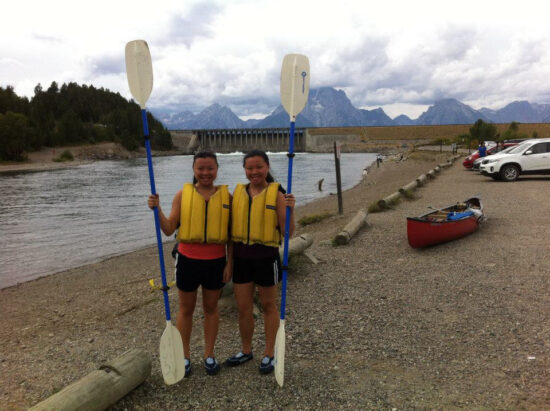
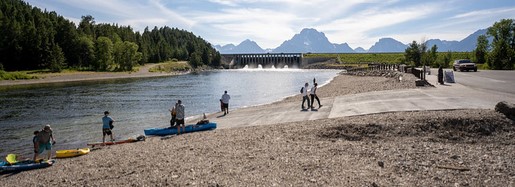
Here, the view of the launch ramp as seen from Jackson Lake dam:

“The Snake River for 150-feet below the downstream face of the Jackson Lake Dam is closed to fishing, swimming, wading and / or bank use.”
There are few obstructions along this 5 mile stretch of the Snake river and only a couple of islands to go around.
In 2010 we did that early morning paddle in drizzle and watched a bald eagle and osprey compete for food.
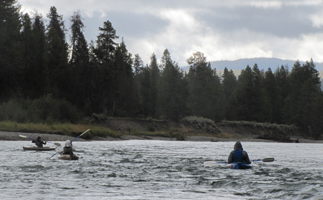
We have seen otters many years, such as this one on the riverbank downstream a ways from the dam, about to get into the water:
2014 we set up a photo for fun:
Here, (2023 photo) a rest-stop and snack time along edge of the river where the water was shallow enough to “park” our boats:
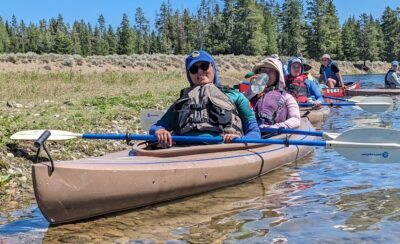
All along this stretch of the Snake River there are often people fishing from boats
(below is a photo near Pacific Creek landing):
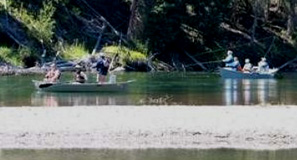
At the end of our down river paddle there is a formal landing point, sometimes with a line of trailers waiting to get their boats up the driveway from the river to the road, at Pacific Creek Landing, just downriver from where Pacific Creek enters the river. (360 degree view from the highway)
Here, the view at the river:

Here, from up at the end of the parking lot, looking down to the river:
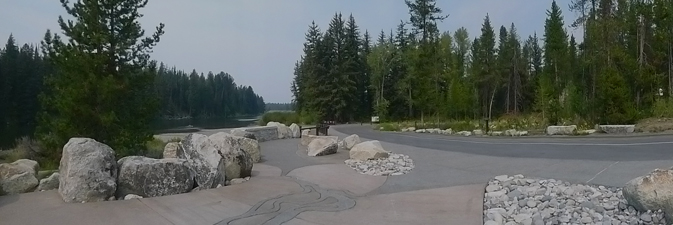
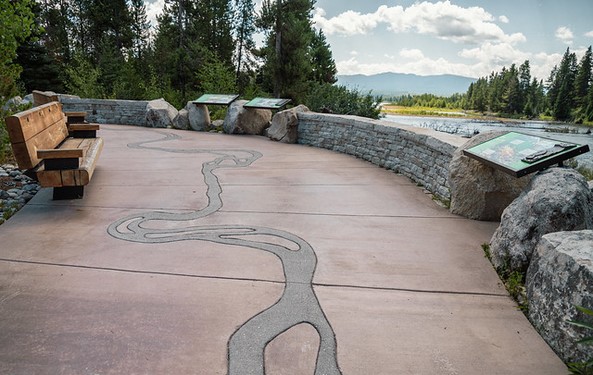
The restroom building is at the side of the large parking lot above the takeout.
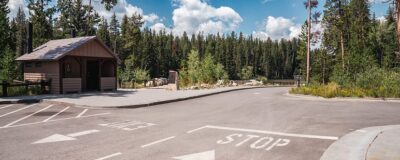
and here, what Pacific Creek landing looked like before the 2021 remodel:
The rest of the Snake River is not for beginners, your flat water experience will be of little use, and if you want to see it you should plan on bringing money for a scenic raft float trip or a whitewater raft trip that would not be an official club event. (The water flow in the Snake River peaks around the end of May.)
A bit further downriver from the Pacific Creek takeout the Snake River has many braided sections. Professional guides can take people on this stretch, but the general public, (even experienced boaters) are discouraged due to risk of getting lost, capsized or having their canoe wrap around a tree in the sometimes fast moving sections of the river.
The park service notes: “Though the Snake River in Grand Teton National Park does not consist of any whitewater, it is a complex and unpredictable braided river. A strong current, shifting channels, numerous logjams, eddies, and snags all combine to make floating the Snake a challenging proposition. These obstacles often require floaters to set up maneuvers well in advance, and inexperienced pilots often make maneuvers too late.”
You might not survive this, even with a lifejacket:

A shorter kayak exploration of the north end of Jenny Lake is a possibility. If the dirt road is passable we could go to Two Ocean Lake.
Grand Teton park’s river etiquette brochure for raft trips says: “The quality of float trips depends largely on the wildness of the river. The very presence of other boaters threatens this quality. Help preserve the tranquility of the river scene. Reduce congestion at landings by preparing craft away from launch slips. Launch when other boats are out of sight, and maintain this interval throughout the trip. Excessive noise disrupts the solitude others seek. Silence is important when passing wildlife. When encountering other boaters and anglers, respect their rights by steering clear of their boats and lines.”
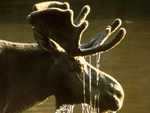
“Any boating accident involving a collision or casualty must be reported to a Ranger Station within 24 hours. All trash must be packed out.”
(And it is Outdoor Club habit to collect trash we find others left behind as we paddle or hike, or even in trailside parking lots.)
Rangers would also like you to note: “Be a responsible wildlife observer. ….Always maintain a safe distance of at least 300 feet from large animals such as bears, bison, moose and elk. Never position yourself between an adult and its offspring. Do not feed wildlife, including ground squirrels and birds. Do not harass wildlife. Harassment is any human action that causes unusual behavior, or a change of behavior, in an animal. Repeated encounters with people can have a negative, long term impact on wildlife, including increased levels of stress and the avoidance of essential feeding areas.”
This is why it is immoral (and illegal) to howl like a wolf in Grand Teton / Yellowstone. If a moose grunts, and you grunt back, it isn’t illegal, but it is dangerous because he may chase you. They are big animals but they are fast and have more of a temper during the fall rutting season and summer baby raising season.
The pictures below are from a video we took. We watched a moose family at Oxbow Bend one morning for at least two hours. First we saw the cow, then later the bull. A different bull came on the scene, but left when approached by the first bull. The moose family wandered towards the far shore from us, where there were a bunch of photographers. We paddled along, keeping our distance. A photographer came down too close towards the shore and was charged by the bull back up the hill (he was unhurt), then the bull moose ran his family to safety (slightly blurry picture captured from video, running through shallow water along the shore). Up until then, because we had been quiet and stayed away from them, the moose had been acting normally. We felt as if we were right in the middle of a famous nature company video, only better with the smells and feel of the morning, and views 360 degrees around. With binoculars we could see everything up close.
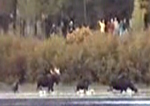

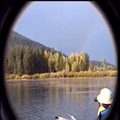
These people on shore another year have almost surrounded a bull moose. Behind them is a steep bank down to the river. If the bull moose gets nervous and wants to escape some of them could be hurt.

You will r e a l l y want your own binoculars.
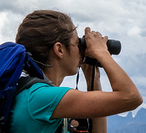 The club advisor brings a few pairs of waterproof binoculars, we can even use while out kayaking, (just be sure to attach the custom-sewn band of floats made from pool lane lines so the binoculars won’t sink if you drop them overboard) but she does not have enough for everyone on a big trip so people will need to share.
The club advisor brings a few pairs of waterproof binoculars, we can even use while out kayaking, (just be sure to attach the custom-sewn band of floats made from pool lane lines so the binoculars won’t sink if you drop them overboard) but she does not have enough for everyone on a big trip so people will need to share.
below, the binoculars with the flotation clipped on, and not clipped on:


With binoculars you can see the river otters up closer when we are out paddling:
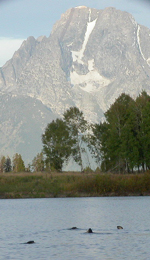
The park service also says “If your actions cause an animal to flee, you have deprived other visitors of a viewing opportunity. Use an animal’s behavior as a guide to your actions and limit the time you spend.”
The Forest Service also also reminds us:
“YOU ARE TOO CLOSE TO WILDLIFE IF:
· The animal stops feeding or resting.
· The animal starts moving either toward or away from you.
· The animal starts panting, huffing or making unusual sounds.
· The animal begins pawing the ground or swinging its head.
· Neck hair or feathers stand up.
· The animal appears nervous, uneasy or stressed.
If you notice these signs you are disturbing the animal and it is time to slowly move away. The safest way to view wildlife is through binoculars or spotting scopes.”

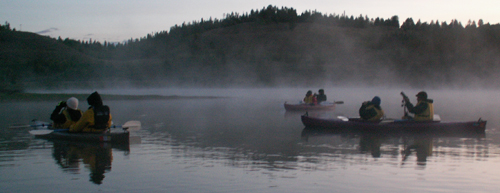
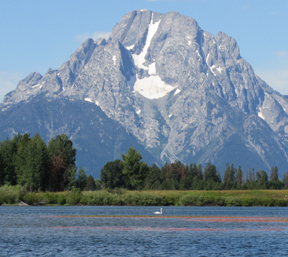

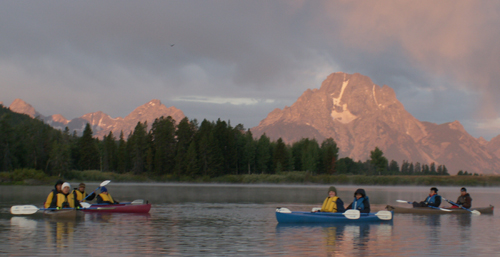

Grizzly bear (wearing a collar because the park service was keeping track of it) in a meadow next to the Oxbow: (your safety in grizzly bear territory)
The NPS notes: “Tagged, or radio collared, bears do not mean the bear is a “bad” bear. Tagging bears is done for better monitoring, and the ear tag color is completely random, used to help quickly identify a bear.”
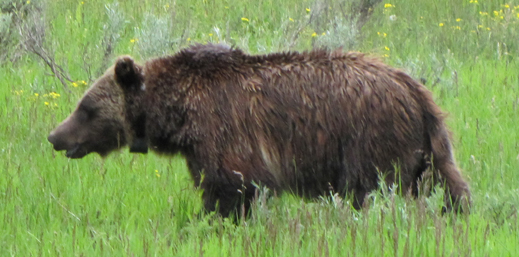
______________________________
From the National Park Service Morning Report of July 15, 2002:
Yellowstone NP (WY) – Visitor Gored by Bison
A bull bison gored 37-year-old Paul Jocelyn of Albertville, Minnesota, near Old Faithful Lodge on the afternoon of July 13th. Witnesses said that the bison was grazing near the boardwalk that connects the lodge with Old Faithful geyser. A group of visitors approached to within ten to fifteen feet to take pictures of the animal. Jocelyn stepped out from the group and walked around to the front of the bison to see if it would raise its head for a better picture. The bison chased Jocelyn into the trees, picked him up with his horns, and threw him three to four feet into the air. The bison then stared at Jocelyn and the other visitors for several minutes before walking off and resuming grazing. Jocelyn sustained a puncture wound to his inner right thigh and various scrapes and bruises. Rangers provided initial care; he was then taken to Old Faithful Clinic for treatment of his injuries. Criminal charges are pending against Jocelyn for harassing wildlife.
No action will be taken against the bison.
see also: before a bison charges
______________________________
We have seen a Bald Eagle and an Osprey dive down to the water, catch a fish and fly away, but have not yet got a photo as good as this one, courtesy of the National Park Service:
Grand Teton National Park birds has photos and details about the most common ones we can hope to see
including Bald Eagle, Red-winged Blackbird, Canada Geese, Clark’s Nutcracker, Golden Eagle, Great Blue Heron.Great Gray Owl, Harlequin duck, Loon, Magpie, Merganser, Northern Flicker (woodpecker), Osprey, Ouzel, Pelican, Peregrine Falcon, Ptarmigan, Raven, Sandhill Cranes, Steller’s Jays, Trumpeter Swan, Western Meadowlark and Western Tanager, with links to calls / songs from most of them to listen to.
and you can Download photos of over a hundred birds of Grand Teton National Park
https://www.audubon.org/climate/national-parks/grand-teton-national-park
___________________________________
If this trip has a large number of participants, we can’t all be out on Oxbow Bend at the same time and expect to be able to see wildlife. The faculty advisor may limit the number of people allowed to kayak on a given day as a result. (Everyone we have kayaks for, who can rent canoes, or can bring their own, can be out on Colter Bay, String Lake, the Snake River at the same time.)
-By signing up for this trip you are agreed to all of this. If, upon reading all this, it seems like too many rules for you (you don’t want to paddle with the group, you don’t want to wear a lifejacket, or you don’t want to stay completely quiet while watching or anticipating watching wildlife), please remember: people on previous kayaking trips have been barred from attending future club events because they did not follow trip rules, and you could even be kicked off this trip before it is finished. If all this puts too many restrictions on your “freedom,” please don’t join us.
and be assured that we will not pack our boats like these people did
(at least they had lifejackets on).
Photo from https://www.nps.gov/yell/planyourvisit/upload/boatingregulations_2022digital.pdf
____________________________________
Pictures and info about visitor centers, Cunningham Cabin, Menor’s Ferry, Chapel of the Transfiguration, Cascade Canyon, Signal Mountain summit road, Colter Bay Indian Arts Museum, Mormon Row and the Wyoming Centennial Scenic Byway are at: Grand Tetons sightseeing
____________________________________
The Teton Wilderness and the Gros Ventre Wilderness are much of the land to the east of Grand Teton National Park up to Yellowstone and to the east of and below the town of Jackson.
Forest Service River Etiquette:
“By following a good river etiquette, you can help others have an enjoyable experience.
To reduce congestion at river launches, always prepare and de-rig your boat away from the boat ramp.
Smaller boats should give the right-of-way to larger, less maneuverable boats.
Allow the boat ahead of you to pass through a rapid before you begin your approach.
Please keep the river clean by using designated restrooms and packing out garbage.
Be considerate. Not everyone welcomes a water fight.”
____________________________________
How much water is in Jackson Lake (reservoir) right now?
Check out the boat ramp link below. Full pool of Jackson Lake (reservoir) is 6769′. The end of the boat ramp at Colter Bay is at 6753′, at the end of the boat ramp at Signal Mountain Lodge is 6737′ and at Leek’s Marina it’s 6735′.
The webpage tells you how high the water level has been on Jackson Lake for the last five days. (Scroll down past the drawing at the top.)
http://www.usbr.gov/pn/hydromet/ramps/jackson/jackson.html
The answer to the question: What is the water flow in the Snake River right now?
is at:
Grand Tetons whitewater rafting which is not an official part of our trips
____________________________________
Wyoming requires an annual Aquatic Invasive Species decal, (prices from the website in 2025) $10 for motorized watercraft registered in Wyoming, $30 for those registered in other states, $5 for non-motorized owned by Wyoming residents, $15 for non-motorized owned by non-residents. (Inflatables under ten feet were exempt as of 2014, but we found no later reference.) You will have to have your boat inspected.
Boating in Grand Teton National Park also requires an annual park permit (prices at the website as of 2025):
$25 Non-motorized boat permit (includes canoes, kayaks, SUPs and drift boats)
$75 Motorized boat permit
(Seven day permits will no longer be offered, as of 2015.)
As of 2014 the Grand Teton permits were no longer reciprocal in Yellowstone and if we want to boat there we will need to pay again.
Almost all the lakes do not allow motorboats.
Motorboats are permitted on Jenny Lake (10 horsepower maximum) and Jackson Lake.
Sailboats, water skiing and windsurfers are allowed only on Jackson Lake.
Jet skis and submersibles are not allowed on/in any park waters.
Underwater diving/ snorkling are allowed only in Jackson and Jenny lakes, within existing limitations on swimming.

Limitations on swimming/wading include not within 150 feet of the downstream face of Jackson Lake dam, not within marinas, boat mooring areas or in the vicinity of the Jenny Lake ferry boat concession.

Floating any river or stream within the park on an air mattress, float tube, inner tube or similar individual flotation device is prohibited.
Windsurf boards are only allowed on Jackson lake and they and all other boats, canoes, kayaks and stand-up paddle boards must have a boat permit which you can obtain at any visitor center.
(Always check current regulations as this website can’t be kept completely up to date as well as park service websites.)
Human powered vessels are permitted on Jackson, Jenny, Phelps, Emma Matilda, Two Ocean, Taggart, Bradley, Bearpaw, Leigh and String Lakes and the Snake River 1000 feet below Jackson Dam. Only human-powered canoes, dories and kayaks are allowed on the Snake River within the park, but most parts of the Snake River have swift water and braided channels where route finding is difficult and are not for beginners. The beginner level section is from Jackson Lake dam to Pacific Creek Landing. There is fast water at the landing and people should scout it before launching.
Inner tubes, air mattresses, float tubes and similar swimming/fishing flotation devices are
prohibited “as a means of conveyance on all streams and rivers.”
The Park says: “User fees for operating a boat within the park help cover the costs for maintaining routine patrols of park lakes and the Snake River. Boating fees also help in supplying equipment and training for aquatic rescue operations.
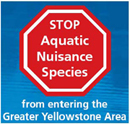 Boats, and anything that comes in contact with the water (a boat trailer that you drive into the water to launch, waders, paddles, Tevas, nets, etc.) must be cleaned before use in the park. They must be cleaned again before use in Yellowstone waters and again when you come back to the Tetons.
Boats, and anything that comes in contact with the water (a boat trailer that you drive into the water to launch, waders, paddles, Tevas, nets, etc.) must be cleaned before use in the park. They must be cleaned again before use in Yellowstone waters and again when you come back to the Tetons.
http://www.nps.gov/grte/planyourvisit/ans.htm
 New Zealand mud snails, shown on a dime in this NPS photo, are only about a quarter of an inch long. They form dense colonies on rocks and aquatic vegetation and crowd out native aquatic insect communities, which are a primary food for fish, which are food for many animals. They also eat the majority of alqae growth in streams, which is a primary food for aquatic invertebrates.
New Zealand mud snails, shown on a dime in this NPS photo, are only about a quarter of an inch long. They form dense colonies on rocks and aquatic vegetation and crowd out native aquatic insect communities, which are a primary food for fish, which are food for many animals. They also eat the majority of alqae growth in streams, which is a primary food for aquatic invertebrates.
____________________________________
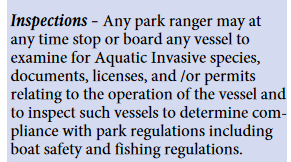 ____________________________________
____________________________________
There are how-to pictures at: loading a kayak on a car ,
canoe over canoe rescue also can be used for kayaks.
– – – – – – – – – – – – – – – – – – – – – – – – – – – – – – – – – – –
Grand Teton National Park boat launch access has maps and answers to questions:
When do Grand Teton National Park and Jackson Lake boat ramps open and close?
Where and how long can I park my boat trailer in Grand Teton National Park?
Can I bring my dog on my boat in Grand Teton National park?
and photos, details & maps about marinas and/or free boat launch ramps at Leeks Marina, Colter Bay, Jackson Lake Dam, Snake River Launch to Pacific Creek Landing, Snake River Launch and take out, Signal Mountain Lodge, and a String Lake launch ramp for non-motorized, hand carried boats
as well as details and maps of boat-in camping on Jackson Lake.
– – – – – – – – – – – – – – – – – – – – – – – – – – – – – – – – – – –
Skipping rocks lessons and/or competitions often happen:

For details about our next club trip to Grand Teton National Park, go to: Grand Tetons.
Grand Tetons trip pages index has brief descriptions of most of the pages about this trip.

Details about loading the kayaks on the trailer are here.
